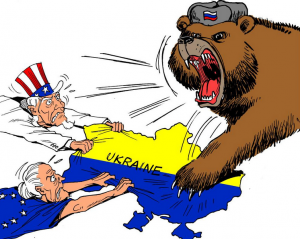
The National Bank of Ukraine (NBU), the country’s central bank, raised interest rates from 12.5% to 14.0% as of today. The move was largely unexpected and gave the Ukrainian hryvnia a solid bid in trading during the Asian session.
The latest rate increase is the third this year, as the NBU struggles to stave off USD demand which is driving the Exchange rate to record lows. Ukraine’s continuing conflict with Russia over the Crimean and Eastern regions is contributing to the exodus of capital leaving the country.
Ukraine is also crippled by rampant inflation with consumer prices rising an eye-watering 19.8% in October compared to 0.5% in January. This is the highest rate of inflation since 2009 and the consequential effects of the GFC which can be partly explained by the government’s decision to raise household utility tariffs in order to qualify for an international bailout from the IMF/World Bank. The confluence of war, geopolitical uncertainty, inflation and capital flight has driven the hryvnia 59% lower agains the US dollar since the start of 2014.
Conflict Is Bad for Business
Market conditions have consistently deteriorated since the Ukraine-Russia conflict began in February of this year, so much so that the NBU expects the Ukrainian economy to contract by 7% this year and the growth outlook for 2015 is equally sombre. According to the NBU, the negative GDP growth over the past year is intensifying… “the decline in real GDP in Q3 was 5.1% compared to 4.6% in Q2 and 1.1% in Q1 respectively."
To make things worse, Ukraine is now obligated to meet a slew of macroeconomic conditions and reforms as prescribed by the IMF and World Bank. When analysing IMF involvement in other countries such as Greece and Cyprus, it is likely that Ukraine will be forced to implement increasingly draconian measures to the detriment of its working population, leading to more unemployment and social unrest. Furthermore, national reserves of currency and precious metals are likely to be appropriated by the IMF, conditional for repayment conditions to being met.

According to an official statement accompanying the rate increase, the NBU said, “A worse market outlook and further hryvnia devaluation are causing additional inflation pressure, which will remain during the beginning of next year.” Adding, “Stabilizing measures taken by the central bank need to be reinforced by rate policy tools toward increasing the domestic value of the hryvnia.”
The NBU cites, “mutual restrictions in foreign trade with Russia” as a core factor for the decline in aggregate output. The two countries not only share an economic link but also a cultural bond that account for the majority of Ukraine’s net trade. Given the geopolitical conflict, many of those ties have been severed.
Pointing the finger of blame at Russia, the NBU states, “ The lack of de-escalation of military aggression against Ukraine led to the exacerbation of negative expectations, manifested in accelerating the outflow of deposits from banks and demand for foreign currency in recent months after some signs of stabilization in June 2014." In July and October, hryvnia outflows reached $16.8 billion. In terms of cash currency, the NBU estimates that approximately $1 billion left Ukraine in July-October.
And the Only Winner Is....
The Russia-Ukraine conflict undermines economic activity in both countries and continues to frighten investors from investing in the region until geopolitical conditions improve. Both countries are engaged in artificially supporting their respective currencies and both are using foreign exchange reserves to sustain value in their own currencies. Both the CBR and NBU have raised interest rates several times this year; with a low-rate environment globally, the only thing higher interest rates do is to stifle domestic business activity.
With the conflict now raging for almost a year, the prime benefactors are Russia's global competitors - the US and the EU. Chinese officials are also likely to be filled with glee as a major global player is tangled up with inflation under international sanctions.
The conflict took a turn for the worse yesterday with NATO reporting that Russian troops entered Eastern Ukraine to support the separatist movement that has only grown since its inception. It is difficult to see how the conflict will de-escalate given the impasse over territorial claims and past indiscretions by both nations.
The NBU is likely to raise rates again while the hryvnia continues to see falling demand. With IMF and World Bank involvement, a hryvnia-US dollar peg is also an option likely to be considered as a way to contain rampant inflation.















